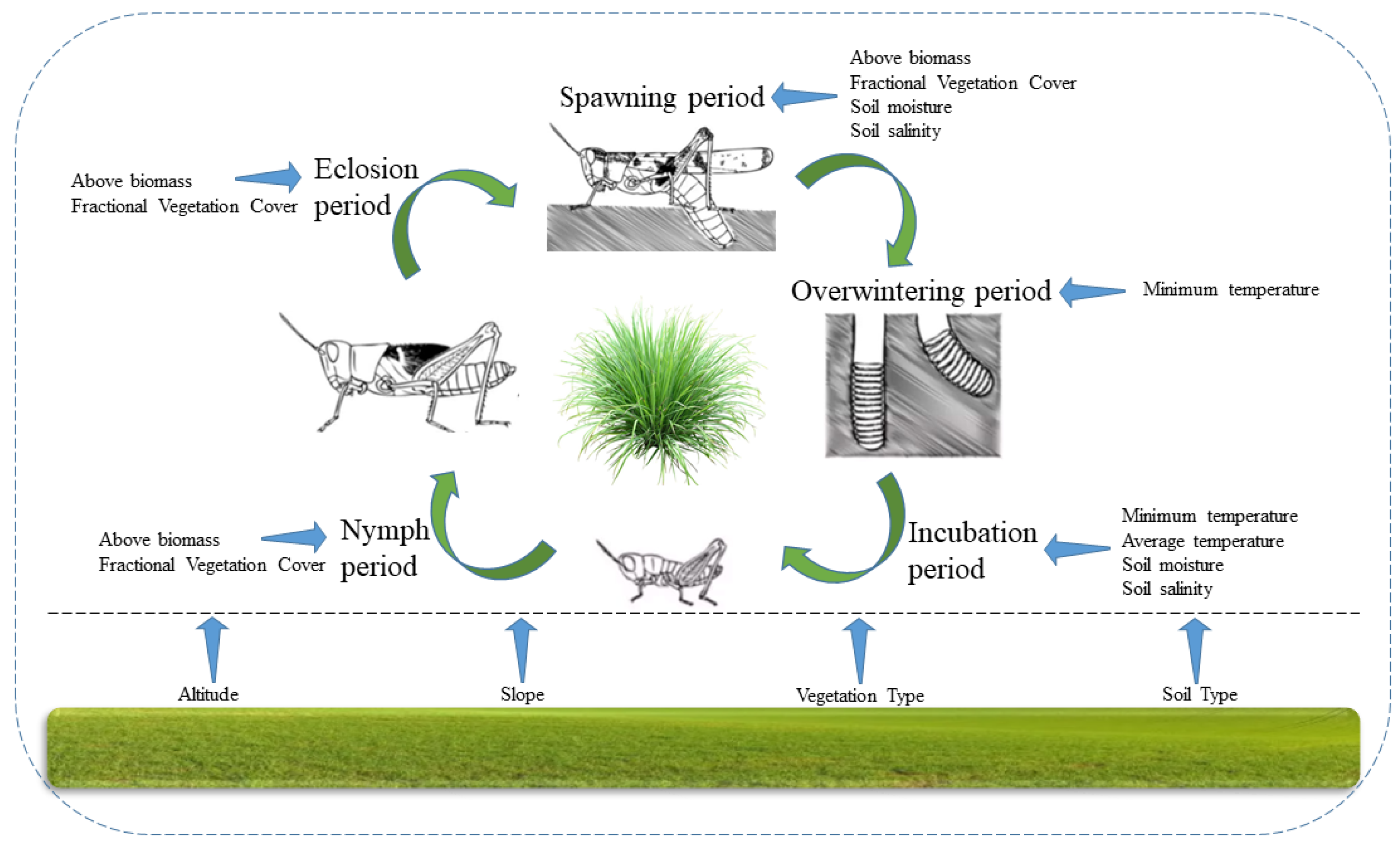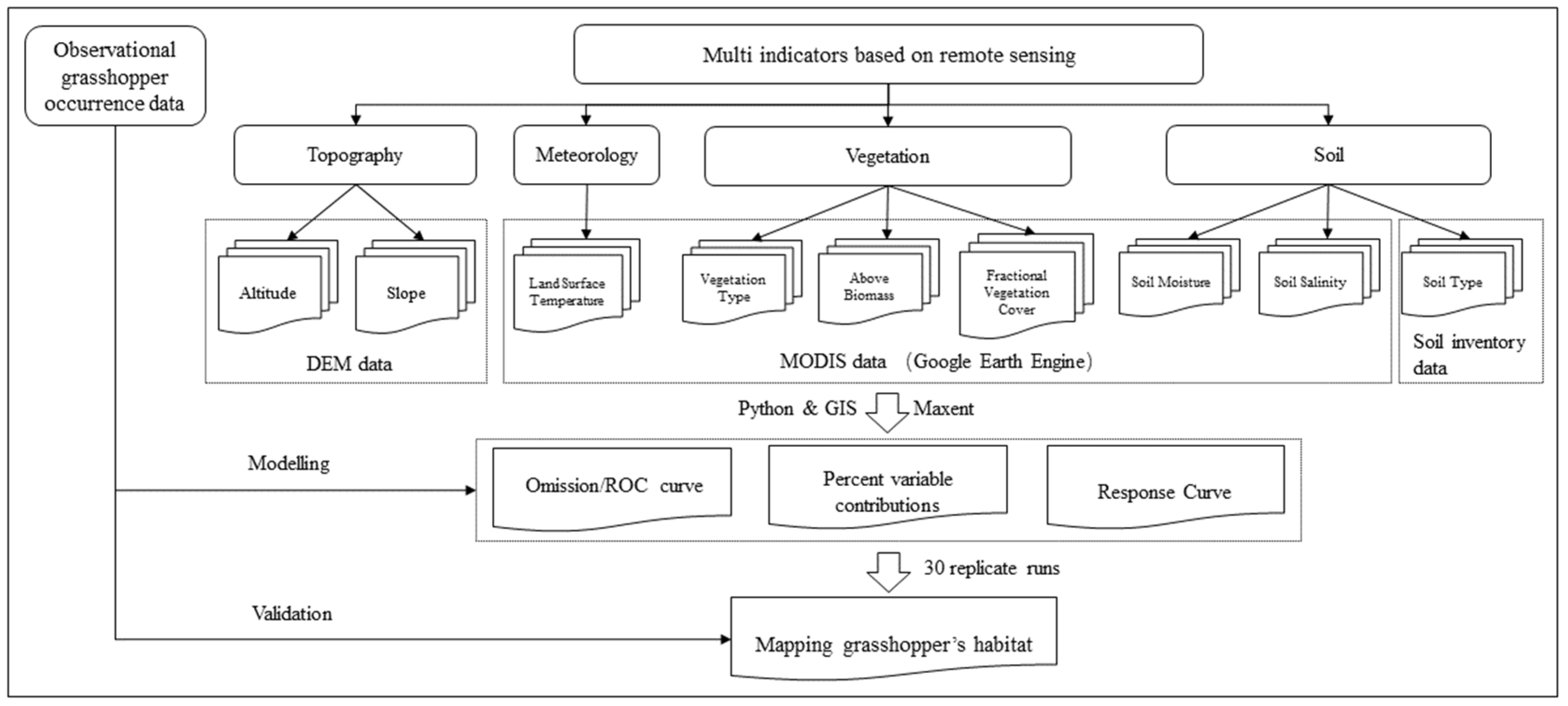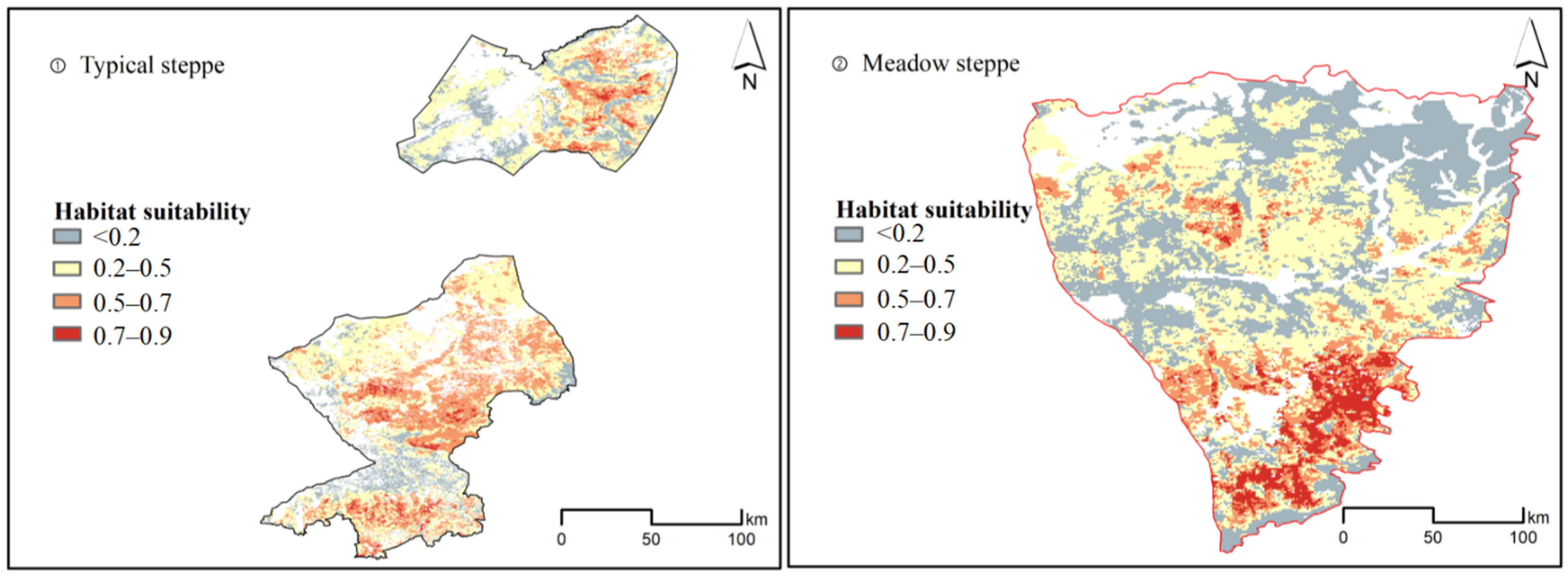Detecting Key Factors of Grasshopper Occurrence in Typical Steppe and Meadow Steppe by Integrating Machine Learning Model and Remote Sensing Data
Abstract
:Simple Summary
Abstract
1. Introduction
2. Materials and Methods
2.1. Study Area
2.2. Investigative Grasshopper Occurrence Data
2.3. Environmental Factors Based on Remote Sensing Data
2.4. Machine Learning Model (Maxent Model) and Validation
2.5. Analysis Framework
3. Results
3.1. The Spatial Distribution of Grasshopper Occurrence in Typical Steppe and Meadow Steppe
3.2. The Key Factors of Grasshopper Occurrence in Typical Steppe and Meadow Steppe
3.3. The Role of Top Contributing Factors for Grasshopper Occurrence in Typical Steppe and Meadow Steppe
4. Discussion
4.1. Environmental Factors Interpreting the Differences between Typical Steppe and Meadow Steppe
4.2. Efficiency of Combining the Maxent Model and Remote Sensing Data
4.3. Management Implications
5. Conclusions
Supplementary Materials
Author Contributions
Funding
Data Availability Statement
Acknowledgments
Conflicts of Interest
References
- Zhang, L.; Lecoq, M.; Latchininsky, A.; Hunter, D. Locust and Grasshopper Management. Annu. Rev. Entomol. 2019, 64, 15–34. [Google Scholar] [CrossRef] [PubMed]
- He, K.; Huang, J.F. Remote sensing of locust and grasshopper plague in China: A review. In Proceedings of the 5th International Conference on Agro-Geoinformatics (Agro-Geoinformatics), Tianjin, China, 18–20 July 2016. [Google Scholar] [CrossRef]
- Olfert, O.; Weiss, R.M.; Giffen, D.; Vankosky, M.A. Modeling Ecological Dynamics of a Major Agricultural Pest Insect (Melanoplus sanguinipes; Orthoptera: Acrididae): A Cohort-Based Approach Incorporating the Effects of Weather on Grasshopper Development and Abundance. J. Econ. Entomol. 2021, 114, 122–130. [Google Scholar] [CrossRef]
- Lucas, J.M.; Jonas, J.; Laws, A.N.; Branson, D.H.; Pennings, S.C.; Prather, C.M.; Strickland, M.S. Functional and taxonomic diversity of grasshoppers differentially shape above- and below-ground communities and their function. Funct. Ecol. 2021, 35, 167–180. [Google Scholar] [CrossRef]
- Shen, J.; Zhang, N.; Gexigeduren; He, B.; Liu, C.Y.; Li, Y.; Zhang, H.Y.; Chen, X.Y.; Lin, H. Construction of a GeogDetector-based model system to indicate the potential occurrence of grasshoppers in Inner Mongolia steppe habitats. Bull. Entomol. Res. 2015, 105, 335–346. [Google Scholar] [CrossRef]
- Belovsky, G.E.; Slade, J.B. Grasshoppers affect grassland ecosystem functioning: Spatial and temporal variation. Basic Appl. Ecol. 2018, 26, 24–34. [Google Scholar] [CrossRef]
- Geng, Y.; Zhao, L.L.; Dong, Y.Y.; Huang, W.J.; Shi, Y.; Ren, Y.; Ren, B.Y. Migratory Locust Habitat Analysis With PB-AHP Model Using Time-Series Satellite Images. IEEE Access 2020, 8, 166813–166823. [Google Scholar] [CrossRef]
- Lemoine, N.P. Phenology dictates the impact of climate change on geographic distributions of six co-occurring North American grasshoppers. Ecol. Evol. 2021, 11, 18575–18590. [Google Scholar] [CrossRef]
- Humbert, J.Y.; Delley, S.; Arlettaz, R. Grassland intensification dramatically impacts grasshoppers: Experimental evidence for direct and indirect effects of fertilisation and irrigation. Agric. Ecosyst. Environ. 2021, 314, 107412. [Google Scholar] [CrossRef]
- Wang, D.L.; Nkurunziza, V.; Barber, N.A.; Zhu, H.; Wang, J.T. Introduced ecological engineers drive behavioral changes of grasshoppers, consequently linking to its abundance in two grassland plant communities. Oecologia 2021, 195, 1007–1018. [Google Scholar] [CrossRef] [PubMed]
- Zhao, Y.X.; Hao, S.G.; Kang, L. Variations in the embryonic stages of overwintering eggs of eight grasshopper species (Orthoptera: Acrididae) in inner Mongolian grasslands. Zool. Stud. 2005, 44, 536–542. [Google Scholar]
- Wettstein, W.; Schmid, B. Conservation of arthropod diversity in montane wetlands: Effect of altitude, habitat quality and habitat fragmentation on butterflies and grasshoppers. J. Appl. Ecol. 1999, 36, 363–373. [Google Scholar] [CrossRef]
- Li, L.L.; Zhao, C.Z.; Zhao, X.W.; Wang, D.W.; Li, Y. Pattern of plant communities’ influence to grasshopper abundance distribution in heterogeneous landscapes at the upper reaches of Heihe River, Qilian Mountains, China. Environ. Sci. Pollut. Res. 2021, 29, 13177–13187. [Google Scholar] [CrossRef]
- Theron, K.J.; Pryke, J.S.; Samways, M.J. Identifying managerial legacies within conservation corridors using remote sensing and grasshoppers as bioindicators. Ecol. Appl. 2022, 32, e02496. [Google Scholar] [CrossRef] [PubMed]
- Zhou, W.; Wang, K.; Zhao, C.; Zhang, Q. Analysis of Spatial Pattern among Grasshopper and Vegetation in Heihe based on GIS. Phys. Procedia 2012, 33, 1261–1268. [Google Scholar] [CrossRef]
- Broder, L.; Tatin, L.; Danielczak, A.; Seibel, T.; Hochkirch, A. Intensive grazing as a threat in protected areas: The need for adaptive management to protect the Critically Endangered Crau plain grasshopper Prionotropis rhodanica. Oryx 2019, 53, 239–246. [Google Scholar] [CrossRef]
- Ozment, K.A.; Welti, E.A.R.; Shaffer, M.; Kaspari, M. Tracking nutrients in space and time: Interactions between grazing lawns and drought drive abundances of tallgrass prairie grasshoppers. Ecol. Evol. 2021, 11, 5413–5423. [Google Scholar] [CrossRef]
- Ni, S.X.; Wang, J.C.; Jiang, J.J.; Zha, Y. Rangeland grasshoppers in relation to soils in the Qinghai Lake Region, China. Pedosphere 2007, 17, 84–89. [Google Scholar] [CrossRef]
- Wu, T.J.; Hao, S.G.; Kang, L. Effects of Soil Temperature and Moisture on the Development and Survival of Grasshopper Eggs in Inner Mongolian Grasslands. Front. Ecol. Evol. 2021, 9, 727911. [Google Scholar] [CrossRef]
- Burt, P.J.A.; Colvin, J.; Smith, S.M. Remote sensing of rainfall by satellite as an aid to Oedaleus senegalensis (Orthoptera: Acrididae) control in the Sahel. Bull. Entomol. Res. 1995, 85, 455–462. [Google Scholar] [CrossRef]
- Nufio, C.R.; Buckley, L.B. Grasshopper phenological responses to climate gradients, variability, and change. Ecosphere 2019, 10, e02866. [Google Scholar] [CrossRef] [Green Version]
- Yadav, S.; Stow, A.; Dudaniec, R.Y. Elevational partitioning in species distribution, abundance and body size of Australian alpine grasshoppers (Kosciuscola). Austral Ecol. 2020, 45, 609–620. [Google Scholar] [CrossRef]
- Buckley, L.B.; Graham, S.I.; Nufio, C.R. Grasshopper species’ seasonal timing underlies shifts in phenological overlap in response to climate gradients, variability and change. J. Anim. Ecol. 2021, 90, 1252–1263. [Google Scholar] [CrossRef]
- Hohl, M.; Jeanneret, P.; Walter, T.; Luscher, A.; Gigon, A. Spatial and temporal variation of grasshopper assemblages recorded in 1981-83 and 2002-03 in Grindelwald, Northern Swiss Alps. In Proceedings of the 13th International Occasional Symposium of the European Grassland Federation, Tartu, Estonia, 29–31 August 2005. [Google Scholar]
- Kistner-Thomas, E.; Kumar, S.; Jech, L.; Woller, D.A. Modeling Rangeland Grasshopper (Orthoptera: Acrididae) Population Density Using a Landscape-Level Predictive Mapping Approach. J. Econ. Entomol. 2021, 114, 1557–1567. [Google Scholar] [CrossRef]
- Wysiecki, M.L.; Arturi, M.; Torrusio, S.; Marta Cigliano, M. Influence of weather variables and plant communities on grasshopper density in the Southern Pampas, Argentina. J. Insect Sci. 2011, 11, 109. [Google Scholar] [CrossRef]
- White, E.G.; Sedcole, J.R. A 20-Year Record of Alpine Grasshopper Abundance, with Interpretations for Climate Change. N. Z. J. Ecol. 1991, 15, 139–152. [Google Scholar]
- Steck, C.E.; Buergi, M.; Bolliger, J.; Kienast, F.; Lehmann, A.; Gonseth, Y. Conservation of grasshopper diversity in a changing environment. Biol. Conserv. 2007, 138, 360–370. [Google Scholar] [CrossRef]
- Poniatowski, D.; Beckmann, C.; Loffler, F.; Munsch, T.; Helbing, F.; Samways, M.J.; Fartmann, T. Relative impacts of land-use and climate change on grasshopper range shifts have changed over time. Glob. Ecol. Biogeogr. 2020, 29, 2190–2202. [Google Scholar] [CrossRef]
- Prinster, A.J.; Resasco, J.; Nufio, C.R. Weather variation affects the dispersal of grasshoppers beyond their elevational ranges. Ecol. Evol. 2020, 10, 14411–14422. [Google Scholar] [CrossRef]
- Leonard, A.; Egonyu, J.P.; Tanga, C.M.; Kyamanywa, S.; Tonnang, H.Z.E.; Azrag, A.G.A.; Khamis, F.M.; Ekesi, S.; Subramanian, S. Predicting the current and future distribution of the edible long-horned grasshopper Ruspolia differens (Serville) using temperature-dependent phenology models. J. Therm. Biol. 2021, 95, 102786. [Google Scholar] [CrossRef] [PubMed]
- Leins, J.A.; Banitz, T.; Grimm, V.; Drechsler, M. High-resolution PVA along large environmental gradients to model the combined effects of climate change and land use timing: Lessons from the large marsh grasshopper. Ecol. Model 2021, 440, 109355. [Google Scholar] [CrossRef]
- Branson, D.H. Effects of Altered Seasonality of Precipitation on Grass Production and Grasshopper Performance in a Northern Mixed Prairie. Environ. Entomol. 2017, 46, 589–594. [Google Scholar] [CrossRef]
- Fartmann, T.; Poniatowski, D.; Holtmann, L. Habitat availability and climate warming drive changes in the distribution of grassland grasshoppers. Agric. Ecosyst. Environ. 2021, 320, 107565. [Google Scholar] [CrossRef]
- Hao, S.G.; Wang, S.P.; Cease, A.; Kang, L. Landscape level patterns of grasshopper communities in Inner Mongolia: Interactive effects of livestock grazing and a precipitation gradient. Landsc. Ecol. 2015, 30, 1657–1668. [Google Scholar] [CrossRef]
- Voss, F.; Dreiser, U. Mapping of desert locust habitats using remote sensing techniques. In New Strategies in Locust Control; Birkhäuser: Basel, Switzerland, 1997; pp. 37–45. [Google Scholar] [CrossRef]
- Matenaar, D.; Bazelet, C.S.; Hochkirch, A. Simple tools for the evaluation of protected areas for the conservation of grasshoppers. Biol. Conserv. 2015, 192, 192–199. [Google Scholar] [CrossRef]
- Word, M.L.; Hall, S.J.; Robinson, B.E.; Manneh, B.; Beye, A.; Cease, A.J. Soil-targeted interventions could alleviate locust and grasshopper pest pressure in West Africa. Sci. Total Environ. 2019, 663, 632–643. [Google Scholar] [CrossRef]
- Joubert, L.; Pryke, J.S.; Samways, M.J. Positive effects of burning and cattle grazing on grasshopper diversity. Insect. Conserv. Diver 2016, 9, 290–301. [Google Scholar] [CrossRef]
- Ortego, J.; Aguirre, M.P.; Noguerales, V.; Cordero, P.J. Consequences of extensive habitat fragmentation in landscape-level patterns of genetic diversity and structure in the Mediterranean esparto grasshopper. Evol. Appl. 2015, 8, 621–632. [Google Scholar] [CrossRef]
- Lu, H.; Han, J.G.; Zhang, L.D. Applications of Spectral Analysis Technique to Monitoring Grasshoppers. Spectrosc. Spectr. Anal. 2008, 28, 2808–2811. [Google Scholar] [CrossRef]
- Tratalos, J.A.; Cheke, R.A. Can NDVI GAC imagery be used to monitor desert locust breeding areas? J. Arid Environ. 2006, 64, 342–356. [Google Scholar] [CrossRef]
- Piou, C.; Lebourgeois, V.; Benahi, A.S.; Bonnal, V.; Jaavar, M.E.; Lecoq, M.; Vassal, J.M. Coupling historical prospection data and a remotely-sensed vegetation index for the preventative control of Desert locusts. Basic Appl. Ecol. 2013, 14, 593–604. [Google Scholar] [CrossRef]
- Singh, D.; Sao, R.; Singh, K.P. A remote sensing assessment of pest infestation on sorghum. Adv. Space Res. 2007, 39, 155–163. [Google Scholar] [CrossRef]
- Phillips, S.J.; Anderson, R.P.; Schapire, R.E. Maximum entropy modeling of species geographic distributions. Ecol. Model 2006, 190, 231–259. [Google Scholar] [CrossRef]
- Flory, A.R.; Kumar, S.; Stohlgren, T.J.; Cryan, P.M. Environmental conditions associated with bat white-nose syndrome mortality in the north-eastern United States. J. Appl. Ecol. 2012, 49, 680–689. [Google Scholar] [CrossRef]
- Saatchi, S.; Buermann, W.; ter Steege, H.; Mori, S.; Smith, T.B. Modeling distribution of Amazonian tree species and diversity using remote sensing measurements. Remote Sens. Environ. 2008, 112, 2000–2017. [Google Scholar] [CrossRef]
- Rebelo, H.; Jones, G. Ground validation of presence-only modelling with rare species: A case study on barbastelles Barbastella barbastellus (Chiroptera: Vespertilionidae). J. Appl. Ecol. 2010, 47, 410–420. [Google Scholar] [CrossRef]
- Gschweng, M.; Kalko, E.K.V.; Berthold, P.; Fiedler, W.; Fahr, J. Multi-temporal distribution modelling with satellite tracking data: Predicting responses of a long-distance migrant to changing environmental conditions. J. Appl. Ecol. 2012, 49, 803–813. [Google Scholar] [CrossRef]
- Graham, C.H.; Elith, J.; Hijmans, R.J.; Guisan, A.; Townsend Peterson, A.; Loiselle, B.A.; The Nceas Predicting Species Distributions Working Group. The influence of spatial errors in species occurrence data used in distribution models. J. Appl. Ecol. 2008, 45, 239–247. [Google Scholar] [CrossRef]
- Dai, J.; Roberts, D.A.; Stow, D.A.; An, L.; Hall, S.J.; Yabiku, S.T.; Kyriakidis, P.C. Mapping understory invasive plant species with field and remotely sensed data in Chitwan, Nepal. Remote Sens. Environ. 2020, 250, 112037. [Google Scholar] [CrossRef]
- Yin, H.; Pflugmacher, D.; Li, A.; Li, Z.G.; Hostert, P. Land use and land cover change in Inner Mongolia—Understanding the effects of China’s re-vegetation programs. Remote Sens. Environ. 2018, 204, 918–930. [Google Scholar] [CrossRef]
- Huang, Y.R.; Dong, Y.Y.; Huang, W.J.; Ren, B.Y.; Deng, Q.Y.; Shi, Y.; Bai, J.; Ren, Y.; Geng, Y.; Ma, H.Q. Overwintering Distribution of Fall Armyworm (Spodoptera frugiperda) in Yunnan, China, and Influencing Environmental Factors. Insects 2020, 11, 805. [Google Scholar] [CrossRef]
- Du, B.; Wei, J.; Lin, K.; Lu, L.; Ding, X.; Ye, H.; Huang, W.; Wang, N. Spatial and Temporal Variability of Grassland Grasshopper Habitat Suitability and Its Main Influencing Factors. Remote Sens. 2022, 14, 3910. [Google Scholar] [CrossRef]
- Javidan, N.; Kavian, A.; Pourghasemi, H.R.; Conoscenti, C.; Jafarian, Z.; Rodrigo-Comino, J. Evaluation of multi-hazard map produced using MaxEnt machine learning technique. Sci. Rep. 2021, 11, 6496. [Google Scholar] [CrossRef]
- Lu, L.; Sun, Z.; Qimuge, E.; Ye, H.; Huang, W.; Nie, C.; Wang, K.; Zhou, Y. Using Remote Sensing Data and Species–Environmental Matching Model to Predict the Potential Distribution of Grassland Rodents in the Northern China. Remote Sens. 2022, 14, 2168. [Google Scholar] [CrossRef]
- Elith, J.; Graham, C.H.; Anderson, R.P.; Dudík, M.; Ferrier, S.; Guisan, A.; Hijmans, R.J.; Huettmann, F.; Leathwick, J.R.; Lehmann, A.; et al. Novel methods improve prediction of species’ distributions from occurrence data. Ecography 2006, 29, 129–151. [Google Scholar] [CrossRef]
- Fitzgibbon, A.; Pisut, D.; Fleisher, D. Evaluation of Maximum Entropy (Maxent) Machine Learning Model to Assess Relationships between Climate and Corn Suitability. Land 2022, 11, 1382. [Google Scholar] [CrossRef]





| Category | Environmental Variables | Spatial Resolution | Data Content and Source |
|---|---|---|---|
| Topography | Altitude | 90 m | (Geospatial Data Cloud, http://www.gscloud.cn/, accessed on 5 November 2020) |
| Slope | 90 m | ||
| Meteorology | Land Surface Temperature | 1 km | Minimum LST: Spawning period (August–October 2019), Overwintering period (November 2019–March 2020), Incubation period (April–May 2020) Mean LST: Incubation period (April–May 2020) (MOD11A2.006 Terra Land Surface Temperature and Emissivity 8-Day Global 1 km, https://lpdaac.usgs.gov/products/mod11a2v006/, accessed on 20 June 2021) |
| Vegetation | Vegetation Type | 1 km | (Resource and Environment Science and Data Center, https://www.resdc.cn/, accessed on 11 July 2019) |
| Above Biomass | 1 km | Nymph period (June 2020), Eclosion period (July 2020) (AB = 26.38e (3.8725 × NDVI), NDVI data derived from MOD13A2.006 Terra Vegetation Indices 16-Day Global 1 km, https://lpdaac.usgs.gov/products/mod13a2v006/, accessed on 20 June 2021) | |
| Fractional Vegetation Cover | 1 km | Nymph period (June 2020), Eclosion period (July 2020) (FVC = (NDVI − NDVIsoil)/(NDVIveg − NDVIsoil), NDVI data derived from MOD13A2.006 Terra Vegetation Indices 16-Day Global 1 km, https://lpdaac.usgs.gov/products/mod13a2v006/, accessed on 20 June 2021) | |
| Soil | Soil Type | 1 km | (Resource and Environment Science and Data Center, https://www.resdc.cn/, accessed on 1 April 2019) |
| Soil Moisture Index | 1 km | Spawning period (August–October 2019), Incubation period (April–May 2020) (TVDI = (Ts − Ts min)/(Ts max − Ts min), Ts max = a × NDVI + b, Ts min = c × NDVI + d, LST data derived from MOD11A2.006 Terra Land Surface Temperature and Emissivity 8-Day Global 1 km https://lpdaac.usgs.gov/products/mod11a2v006/, accessed on 20 June 2021, NDVI data derived from MOD13A2.006 Terra Vegetation Indices 16-Day Global 1 km https://lpdaac.usgs.gov/products/mod13a2v006/, accessed on 20 June 2021) | |
| Soil Salinity Index | 1 km | Spawning period (August–October 2019), Incubation period (April–May 2020) , Bg and Br are the reflectance in the green band and red band that are derived from MOD09A1.006 Terra Surface Reflectance 8-Day Global 500 m, https://lpdaac.usgs.gov/products/mod09a1v006/, accessed on 20 June 2021) |
| Level of Suitability | Typical Steppe | Meadow Steppe |
|---|---|---|
| Unsuitable | 37.4% | 40.0% |
| Low | 38.1% | 41.5% |
| Moderate | 22.6% | 12.9% |
| High | 2.0% | 5.7% |
| Typical Steppe | Meadow Steppe | ||
|---|---|---|---|
| Environmental Variables | Percentage Contribution | Environmental Variables | Percentage Contribution |
| Soil type | 21.9% | Abio_Nymph | 33% |
| Abio_Eclosion | 17.5% | Altitude | 29.6% |
| FVC_Nymph | 17% | Soil type | 9.8% |
| Altitude | 12.5% | Lstmin_Overwintering | 8.7% |
| Lstmin_Incubation | 11.8% | ||
| Total | 80.7% | Total | 81.1% |
Publisher’s Note: MDPI stays neutral with regard to jurisdictional claims in published maps and institutional affiliations. |
© 2022 by the authors. Licensee MDPI, Basel, Switzerland. This article is an open access article distributed under the terms and conditions of the Creative Commons Attribution (CC BY) license (https://creativecommons.org/licenses/by/4.0/).
Share and Cite
Lu, L.; Kong, W.; Eerdengqimuge; Ye, H.; Sun, Z.; Wang, N.; Du, B.; Zhou, Y.; Weijun; Huang, W. Detecting Key Factors of Grasshopper Occurrence in Typical Steppe and Meadow Steppe by Integrating Machine Learning Model and Remote Sensing Data. Insects 2022, 13, 894. https://doi.org/10.3390/insects13100894
Lu L, Kong W, Eerdengqimuge, Ye H, Sun Z, Wang N, Du B, Zhou Y, Weijun, Huang W. Detecting Key Factors of Grasshopper Occurrence in Typical Steppe and Meadow Steppe by Integrating Machine Learning Model and Remote Sensing Data. Insects. 2022; 13(10):894. https://doi.org/10.3390/insects13100894
Chicago/Turabian StyleLu, Longhui, Weiping Kong, Eerdengqimuge, Huichun Ye, Zhongxiang Sun, Ning Wang, Bobo Du, Yantao Zhou, Weijun, and Wenjiang Huang. 2022. "Detecting Key Factors of Grasshopper Occurrence in Typical Steppe and Meadow Steppe by Integrating Machine Learning Model and Remote Sensing Data" Insects 13, no. 10: 894. https://doi.org/10.3390/insects13100894





